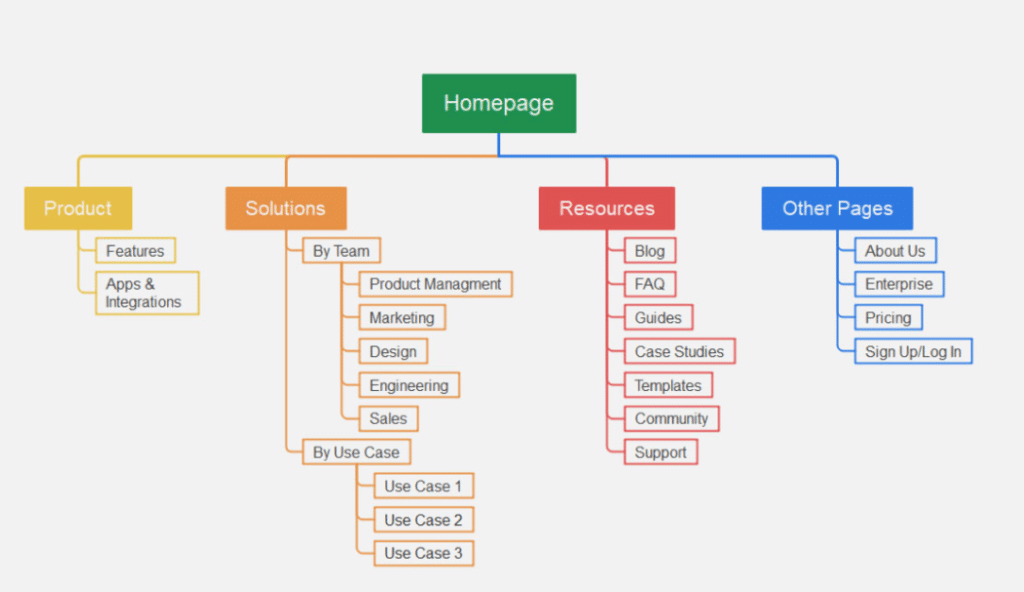You went through the trouble of building your website in the first place. Now, you want it to work for you.
Most of a website’s success stems from attracting users in the first place, and for that, you need to do well with search engines. When people use Google, you want the search results to point to your site. Achieving that goal comes from the practice of SEO.
Within that practice, you have a specific tool at your disposal. It doesn’t constitute the whole of SEO, but it’s important enough for you to read about it today. That tool is known as a sitemap.
- What Is a Sitemap?
- What Is the Purpose of a Sitemap?
- Benefits of Sitemaps
- How to Create a Sitemap
- What Should Be in a Sitemap?
- How to Submit a Sitemap to Google
- How to Use a Sitemap
- Real-World Examples of Effective Sitemaps
- Conclusion
- Sitemaps FAQ
What Is a Sitemap?
When you have a website, it often consists of multiple pages. All of those pages fall under a general domain. For example, this post is on the Rock Content bog. The main domain is rockcontent.com, and the blog is a section of the website under that primary domain.
A sitemap is a list of every page for a website that is under the main domain. So, any page you can load on the Rock Content domain should be visible on the sitemap.
Sitemaps come in different shapes, sizes, and designs, and they offer many uses and purposes — all of which will be covered in this post.
As you go through it, remember that in most cases, sitemaps are either made in XML or HTML. You can also have both.
What Is the Purpose of a Sitemap?
We can think of 3 main purposes:
1- Facilitating search engine crawling
The leading reason to use a sitemap is to make it easier for search engine crawlers to navigate your entire site. This usually helps your SEO rankings, as the crawlers can more easily ascertain the content and value of your site.
It’s worth noting that XML maps tend to optimize better for this purpose.
How does this work?
It’s pretty simple. Web crawlers automatically navigate web pages to take note of all content and put that through their algorithms for search rankings.
When you have an optimized XML sitemap, the crawlers will view that, and it will help them make decisions about how they organize and catalog the information for the search engines. Basically, you’re giving the crawlers a road map to follow. That reduces any risks of making mistakes with your content or even failing to identify some content on your site altogether.
2- Enhancing user navigation
The other leading reason for sitemaps caters to users. HTML sitemaps can make it easier for humans to find what they want on your website. That’s good for traffic, user satisfaction, and most other metrics you might watch after you publish a website.
3- Indicating updates and changes
Finally, both XML and HTML sitemaps help inform people (and search engines) when you make any changes to the site. You just added a whole merchandise catalog that wasn’t there before? Your sitemap will make that obvious.
Benefits of Sitemaps
We’ve said, it works like a map to crawlers. Here are more details:
Improved indexing
You have already seen that sitemaps help web crawlers find things on your website and tag them correctly. This leads to better indexing.
Indexing is a term used by search engines to describe how they catalog information on the internet. Those catalogs are then put through search engine algorithms to determine which sites show up at the top of the list.
Your sitemap helps these systems tag your content so that it is indexed correctly in their master catalogs.
Better SEO performance
Naturally, if you want to show up first in search results, proper indexing becomes paramount. If the web crawlers are not tagging your site correctly, it can and likely will adversely affect your results.
A simple sitemap prevents the most common errors, and that usually improves your search results right away.
Perhaps more importantly, the sitemap also shows the web crawlers how you value and rank information on your site. The map shows a hierarchy of the pages in the domain. Whatever you put at the top of the site is assumed to be the most valuable, and that impacts how the algorithms present your content to search queries.
Additionally, your sitemap shows a list of updates and changes, so if you put some work into SEO, that will be reflected in the sitemap, and it can help the search engines find and account for those changes faster.
Enhanced visibility for new content
Remember how sitemaps can help users and search engines see when you change or add things? Well, that provides a direct benefit when someone visits your website. You can use the sitemap to funnel people to the new content, making it easier to find and more noticeable in the first place.

How to Create a Sitemap
I know it may sound scary, but the good news is: it’s simple.
Tools and methods
As you learn how to make a sitemap, you will find that you can create sitemaps by hand or using automation tools.
If you create it by hand, you just need a text editor that allows you to save XML files. You can use that to create the map, and then you can upload the XML file to Google for indexing.
If you want to use automation tools, you have a plethora of options.
Some of the best sitemap generator tools include the following:
- XML-Sitemaps.com
- Rank Math
- Slickplan.com
- Sitebulb
- And countless others
Many tools support both XML and HTML, but make sure any tool you pick can generate in the language you choose.
Creating an XML sitemap step-by-step
The easiest way to create an XML sitemap is to use a generator tool. The exact steps will depend on the tool you pick, but here’s what you can expect:
- List every URL on your website.
- Enter the list into your generator tool. It should code them into XML for you.
- Tag the sitemap. You can add information like when the page was modified last or how often you make changes.
- Submit the site to Google.
If that seems easy, it is. Most tools simplify the process and walk you through each step.
If you want to do things by hand, you can follow the steps laid out by Google. It’s the same process, but you’re typing things yourself, which will take a little more time than using a generator.
Common mistakes to avoid
Sitemaps can be simple, but there are still common mistakes.
The most common is having an out-of-date map. If you change your website, update the sitemap. You only need to add the new pages, subtract deleted pages, and change the tags to reflect the changes. In most cases, it takes a few minutes.
Also, focus on consistency. The sitemap should match the layout of your website content. That’s where you get the most SEO value.
At the same time, clarity is everything. A sitemap should not feel like a maze, and it should not feel complicated. You’re trying to make things easy for users and bots.
Lastly, make it accessible. The XML map is great for search engines, but your map can also improve the user experience. Make the HTML map visible (usually as a header or at the bottom of each page).
What Should Be in a Sitemap?
Essential elements of a sitemap
You want to include every page that you would like to appear on search engines. For large sites, that might take some time, but you do want all of them on the map, and organized logically.
If you’re unsure where to start, focus on the most important pages and then build from there:
- Home page
- Category pages
- Subcategories
- Contact
- Blog
- Brand information
Priority and frequency tags
In addition to the content list, you want accurate tags. The most important tags are priority and frequency.
Priority tags allow you to rank your own content for the search engines. You can rank things from 0.0 to 1.0, where 1.0 is the most important. Tags default to 0.5, so rank your most important pages higher than that and your least important pages lower than that. Ranking everything at a 1.0 will not help your search results. Create a hierarchy based on how you value your content.
Frequency tags tell the crawlers how often you typically make changes to the site. These tags start at “never” and scale to “always.” If you are not constantly updating the site, you can pick a timeframe that makes sense for how you manage the site. Remember the scale includes hourly, daily, weekly, monthly, and yearly.
How to Submit a Sitemap to Google
Using Google Search Console
First, navigate to the Google Search Console. You will need to sign in to get started.
On the side of the page is a bar that allows you to select your website. Go ahead and do that. There will be an option labeled “Sitemaps.” Click on it.
You will see a list of any submitted sitemaps. If you have not submitted a map, click on the box labeled “Add a new sitemap.” It will allow you to upload the sitemap, and once you do, click “submit.”
Once you submit, it will show up in the list of sitemaps. If there are any problems, the list will show you specific errors that were found with yours. You can correct them, update the map, and you will be good to go.
Best practices for sitemap submission
After you submit the map, confirm that it is in the submitted list and free of errors.
If you have a large website, remember that map does have a size limit: 50MB or 50,000 URLs.
How to Use a Sitemap
Integrating sitemaps with SEO strategies
When you devise an SEO strategy, you will identify specific pages where you want to steer traffic. Make sure those are listed correctly in your sitemap, and prioritize them accordingly.
If your strategy shifts over time, update the tags and priorities to reflect your new strategy.
The sitemap is a single tool in this endeavor. Simply keep it up to date as you go, and it will serve you well.
Monitoring and updating sitemaps
You should periodically check in on your sitemap. Make sure Google can still see all of your pages (on the Search Console). Make changes to the sitemap as needed, and upload those changes in the console.
These simple practices will keep your sitemap up-to-date and functional.
If your site is large enough, consider sitemap audits. They allow you to take a detailed look at the whole site periodically. This ensures that information is accessible and logical and helps you extract the most value from your sitemaps.
Real-World Examples of Effective Sitemaps
E-commerce
A great example of an HTML sitemap can be found on Aribnb.com (in a footer at the very bottom of the page). With countless listings under the domain, Airbnb is managing a huge list. Yet, the sitemap is easy to understand and follow.
Content-rich blog
If you want to see a sitemap working hard in a more content-focused space, then look no further than Gizmodo. As one of the most popular blogs of all time, it can show you exactly what a content-focused sitemap looks like.
One more example here
Perhaps the best was saved for last. Amazon is one of the largest and most used websites in the world. It would seem a waste to exclude it from these examples. So, here’s one among the many Amazon sitemaps. You can see that it covers specific information in a clean and easy-to-follow way.
Conclusion
Sitemaps can boost your SEO by helping you optimize your website layout. More importantly, they tell web crawlers critical information that aids in indexing. On top of that, they can help users navigate your site, leading to a better experience.
If you want to push your SEO to the next level, including professional help with sitemap planning and creation, then start with our on-page SEO checklist.
Sitemaps FAQ
What are sitemaps used for?
Sitemaps are used by search engines to understand the layout of a website and prioritize pages and information within the site. They are also used by people to navigate to the page they want when visiting a site.
Are sitemaps still a thing?
Yes, sitemaps are still a thing. In fact, Google recommends keeping your sitemap up to date.
Where are sitemaps?
Sitemaps are lists that show the structure of pages within your website. They show where individual pages fit within the hierarchy of the whole site.
What are the main types of sitemaps?
You can make XML and/or HTML sites. XML sitemaps are for Google bots to help them index your site. HTML sitemaps are for users to see the easy navigation on your page.
Are sitemaps necessary for SEO?
Sometimes. Very small websites that are not updated frequently can get away with skipping sitemaps, assuming you have good internal linking. For all other websites, sitemaps help with your SEO rankings.
What is the difference between a website and a sitemap?
The website is the content that people can browse on the internet. It includes all of the front-facing and behind-the-scenes information necessary for the website to work.
A sitemap is really just a clean list of all of the pages on your website that can help search engines and people get what they want.
Is it OK to have multiple sitemaps?
Yes. In fact, for large enough sites, this becomes mandatory. You can create sitemaps for different purposes. All of your static or slowly changing content can live on one map, while your rapidly changing content might live on a different map.
Do search engines use sitemaps?
Yes. The sitemap helps the engines catalog your information. You can also use tags to tell the engine which pages are most important within your website and how often they should check back in to rank the changes you make.
Are sitemaps automatically generated?
No. Search engines do not automatically generate sitemaps. That said, automation tools can do all or most of the work for you. As an example, some content management systems will make sitemaps for you as a service.





![12 Best FAQ Pages to Inspire you [+ How to Create Your Own]](https://rockcontent.com/wp-content/uploads/2021/08/best-faq-pages-300x158.png)

